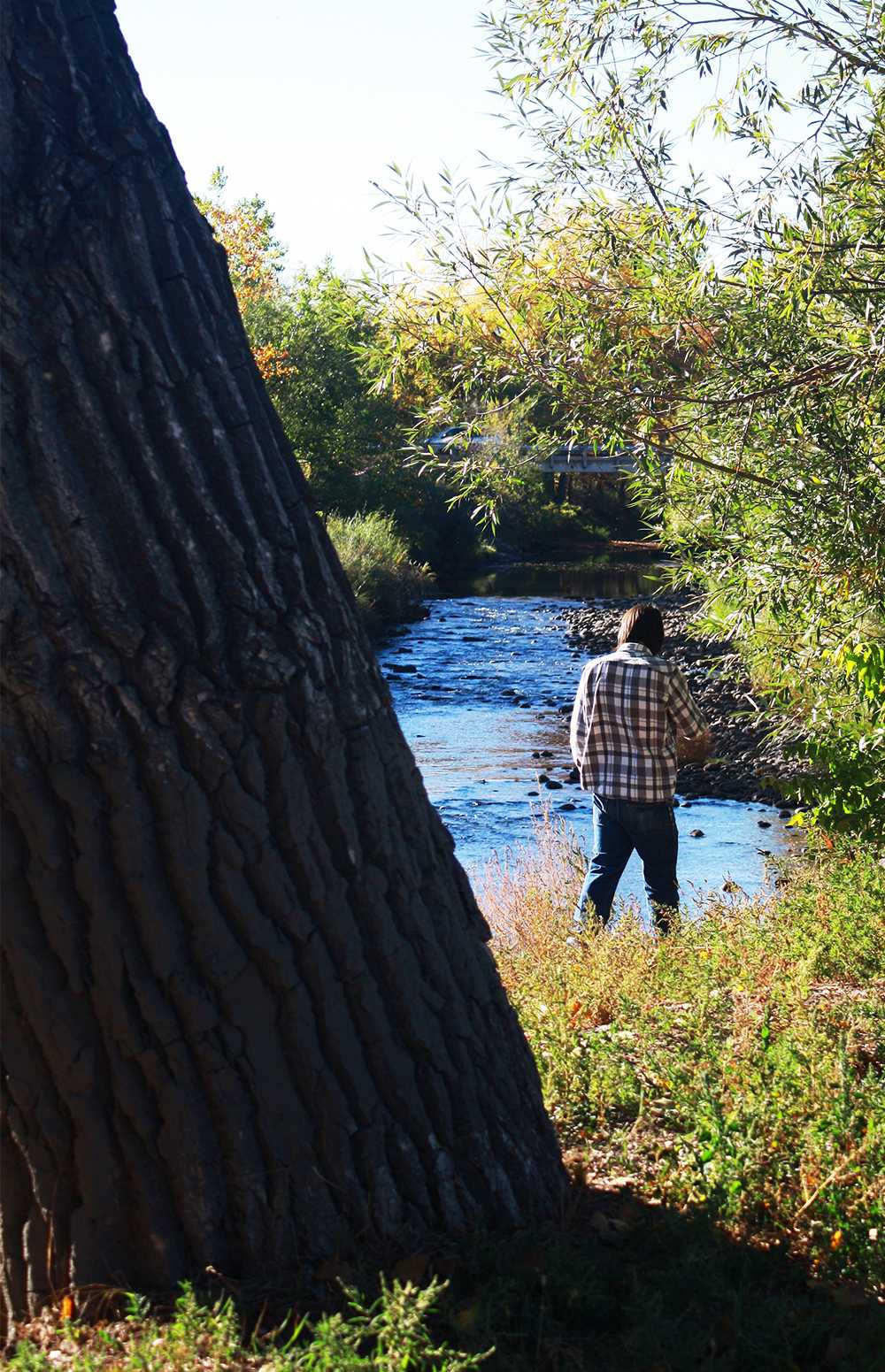
The second largest fire in Colorado history is providing CSU researchers a rare opportunity to study the effects of fire on a high altitude river.
“The High Park Fire represents a unique opportunity from a scientific perspective to see how a fairly large, snowmelt driven river responds to loss of most of the vegetation in the watershed and destabilization of the soil,” said LeRoy Poff, an aquatic ecologist at CSU.
Ignited by a lightning strike west of Fort Collins, June 6, 2012, the High Park Fire consumed over 87,000 acres of land, burned 259 homes and cost almost $40 million before it was contained June 30.
Poff said the only other fire that has similar conditions as the High Park Fire is the Yellowstone fire from the 1980s.
Last summer, the first big thunderstorms after the fire moved a tremendous amount of ash and sediment into the river, turning it into an oily, black mixture. A black sludge accumulated on the river shores that were once covered in pink and tan sands.
Dan Baker, a research scientist in the Department of Civil and Environmental Engineering at CSU, is measuring sediment conditions and the geometry of the river channel to see how the fire runoff will impact the river this year.
His department has eight sites along the river from Bliss to Martinez park off of I-25 that will be measured three times a year.
“It’s exciting, there’s a whole series of practical questions,” Baker said of the one time opportunity to conduct research on the impacts of a fire on a canyon river like the Poudre.
Baker listed a number of variables that will determine if the river is flooded with ash debris again this summer.
Vegetative regrowth, moisture and drought conditions, the severity, location and frequency of summer thunderstorms and the water levels of the river itself will determine the impact of runoff.
One variable many people would be surprised to know isn’t a large factor is snow levels.
Baker said there’s a big difference between the elevation where the heavy snowpack is and the burn area itself. He said most of the snowmelt will bypass the burn area entirely, with spring and summer thunderstorms having the biggest effect of washing ash and debris into the river.
“That’s the important thing. The reality is not much snow runoff is coming from the burn area,” Baker said. “The rainfall will drive it and that’s the big thing.”
Kevin Bestgen, a researcher at the department of fish and wildlife biology at CSU, said the first effect of any fire on is the simple fact that the flames can heat up the water, outright killing sensitive species like trout.
“We don’t know if that happened,” Bestgen said, explaining that the area was restricted during the fire and people weren’t on the ground to take measurements.
This summer, more scorched plant material and black carbon will flow into the river from the mountain hillsides, increasing turbidity-or cloudiness or haziness-of the water.
As the material decomposes, it depletes the oxygen that is vital for the health of insect and fish populations found in the pools and riffles of the Poudre River .
“If the space between stream substrate fills in it will be less productive for insects and less useful as cover for fish,“ Bestgen said. “It can suffocate insects outright or at the very least just reduce the space that’s available.”
Current observations and testing have indicated there hasn’t been a “huge” observed effect on trout populations on the river. While the overall species composition was the same, suckers, minnows and darter fish suffered losses of around 50 percent
“Typically those suckers are a hardy species and we don’t know why they suffered those kind of losses,” Bestgen said.
The gills aquatic insects and fish have are sensitive and can be irritated by the ash and sediment from the burn area. Between oxygen depletion from the breakdown of sediment and the abrasive nature of the ash and sediment on gill structures, Bestgen worries about the impact on the fish and insect populations.
“Any sort of sediment or fine particulate matter that might clog gills can kill them outright if the concentrations are large enough,” Bestgen said.
He added that changes in water chemistry will be a big factor, as ash has a history of being used to make lye and soap, and high enough concentrations can kill fish.
Yet to be determined is how the runoff will affect spawning numbers of the brown trout population. The brown trout spawn in late fall, with the eggs hatching about a month later. The eggs require a full stream of gravel and plenty of oxygen rich water flowing over them for proper incubation.
“If there’s a lot of sediment and ash in the gravel it could affect the reproductive success of the brown trout, we’ll be able to measure that this year,” Bestgen said.
Bestgen said insects are important as a food source this time of year because nothing is falling into the water from the terrestrial environment. While the insects are sensitive, he said that they could reproduce and recover more quickly than the brown trout which has a longer lifespan.
On a recent Friday afternoon, Chip Belcher, an ecology graduate student at CSU, made a trip up the river to Elkhorn Creek to collect samples of winter emerging stoneflies, also known as snowflies.
Walking along the banks of the semi-frozen creek, Belcher looked for the adults that had recently emerged from the water onto land.
In their early life stages, these snowflies spend spring and summer deep in the stream bed in a state of inactivity and then move up into the stream bottom during the fall and early winter.
They then feed on dead leaves and other detritus and emerge as adults in the dead of winter. The emerged adults will make a one-time trip onto land, where they will live out the rest of their short life.
This sunny, winter afternoon saw a small handful of the insects on the snowy stream banks as they made this important transition from water to land. Spotting a crawling insect, Belcher would dip a pair of tweezers into a bottle of ethanol and place a drop on the stonefly.
He then plucked the stunned insect from the icy terrain and placed it in the ethanol. Once back at the lab as CSU, he would place the specimens under a microscope to identify the species and gender of the insects, helping researchers get an accurate count of the numbers found along the tributaries of the Poudre River.
One species of snowfly, the Arapahoe Snowfly, is being considered to be added to the U.S. Fish & Wildlife Service Endangered Species List and is the focus of Belcher’s current research. By researching this species of winter snowfly, he hopes to learn more about ecological requirements and distribution of the Arapahoe Snowfly.
Like other researchers, Belcher is concerned about the effects of ash and sediment runoff from the High Park Fire.
Echoing Bestgen, he listed oxygen depletion, changing water chemistry and the clogging of areas where insects and fish congregate as factors that will determine effects on biological populations.
“Changes in flow patterns or wetness of the stream beds are also a concern, because this would have the potential to impact the availability of substrate and resources for the Arapahoe Snowfly,” Belcher said.
His continuing research throughout the rest of the year will help in determining what the effects of the runoff will be.
Belcher said stoneflies are important for the ecosystem because not only do they provide food for aquatic, avian and terrestrial species but “shredders” they process large amounts of large organic material, making it available to other feeding groups in the stream.
A hard working river
Both Bestgen and Poff agreed that the Poudre River is a “working river”.
Water is diverted for agricultural and industrial use, it collects wastewater with pollutants in it and is a “hard working river with lots of uses and impacts,” Bestgen said.
The river is not a pristine environment to begin with and at some points in the summer, parts of the river go dry from being diverted. Because of this, Poff believes the organisms in the river are fairly resilient and are used to being stressed.
“The river will recover,” Poff said. “We just don’t know how long it will take.”
With many researchers dedicating years if not decades to studying the Poudre River and other ecosystems in Northern Colorado, having a chance to observe the river as it undergoes its latest challenge holds personal significance to those who intimately know its characteristics.
“We care about the Poudre,” Poff said. “It’s the river in our backyard. We take classes out there, we want students to know the river and this is an opportunity for people to come together.”
Senior Reporter Austin Briggs can be reached at news@collegian.com.






